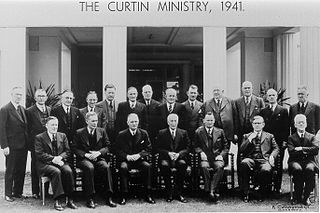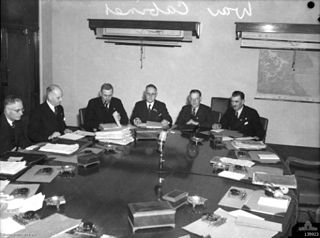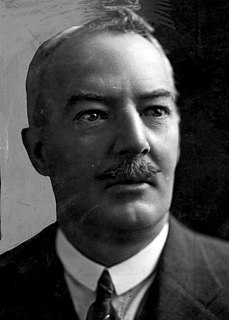
Joseph Benedict Chifley was an Australian politician who served as the 16th prime minister of Australia from 1945 to 1949. He held office as the leader of the Australian Labor Party (ALP).

John Curtin was an Australian politician who served as the 14th prime minister of Australia from 1941 until his death in 1945. He led the country for the majority of World War II, including all but the last few weeks of the war in the Pacific. He was the leader of the Australian Labor Party (ALP) from 1935 to 1945, and its longest serving leader until Gough Whitlam.

Francis Michael Forde was an Australian politician who served as prime minister of Australia from 6 to 13 July 1945. He was the deputy leader of the Australian Labor Party (ALP) from 1932 to 1946. He served as prime minister in a caretaker capacity after the death of John Curtin, and is the shortest-serving prime minister in Australia's history.

The deputy prime minister of Australia is the deputy chief executive and the second highest ranking officer of the government of Australia. The office of deputy prime minister was officially created as a ministerial portfolio in 1968, although the title had been used informally for many years previously. The deputy prime minister is appointed by the governor-general on the advice of the prime minister. When Australia has a Labor government, the deputy leader of the parliamentary party holds the position of deputy prime minister. When Australia has a Coalition government, the Coalition Agreement mandates that all Coalition members support the leader of the Liberal Party becoming prime minister and mandates that the leader of the National Party be selected as deputy prime minister.

The Scullin Ministry (Labor) was the 19th ministry of the Government of Australia. It was led by the country's 9th Prime Minister, James Scullin. The Scullin Ministry succeeded the Third Bruce Ministry, which dissolved on 22 October 1929 following the federal election that took place on 12 October which saw Labor defeat Stanley Bruce's Nationalist–Country Coalition. The ministry was replaced by the First Lyons Ministry on 6 January 1932 following the federal election that took place in December which saw the United Australia Party defeat Labor. As of 2020, it remains the most recent government to have lost an election after a single term in office.

The First Curtin Ministry (Labor) was the 29th ministry of the Government of Australia. It was led by the country's 14th Prime Minister, John Curtin. The First Curtin Ministry succeeded the Fadden Ministry, which dissolved on 7 October 1941 after the independent crossbenchers Alexander Wilson and Arthur Coles withdrew their support for the Fadden Government. The ministry was replaced by the Second Curtin Ministry on 21 September 1943 following the 1943 federal election.

The Second Curtin Ministry (Labor) was the 30th ministry of the Government of Australia. It was led by the country's 14th Prime Minister, John Curtin. The Second Curtin Ministry succeeded the First Curtin Ministry, which dissolved on 21 September 1943 following the federal election that took place in August. The ministry was replaced by the Forde Ministry on 6 July 1945 following the death of Curtin - the second of three occasions where a sitting Prime Minister died in office.

The First Chifley Ministry (Labor) was the 32nd ministry of the Government of Australia. It was led by the country's 16th Prime Minister, Ben Chifley. The First Chifley Ministry succeeded the Forde Ministry, which dissolved on 13 July 1945 following the election of Chifley as Labor leader after the death of former Prime Minister John Curtin. The ministry was replaced by the Second Chifley Ministry on 1 November 1946 following the 1946 federal election.

Edward James "Jack" Holloway was an Australian politician who served in the House of Representatives from 1929 to 1951, representing the Labor Party. He served as a government minister under James Scullin, John Curtin, Frank Forde, and Ben Chifley.
There are Leaders of the Australian Labor Party (ALP) at the federal level as well as in each Australian state and territory. Australian Labor Party leaders are chosen from among the members of the respective parliamentary parties either by the members only or with an input from the ALP rank-and-file members.

John Ignatius Armstrong AC was an Australian politician and diplomat. He served as a Senator for New South Wales from 1938 to 1962, representing the Labor Party, and was a minister in the Chifley Government. Armstrong later served as Lord Mayor of Sydney from 1965 to 1967, and then as High Commissioner to the United Kingdom from 1973 to 1974.

Norman John Oswald Makin AO was an Australian politician and diplomat. He was an Australian Labor Party member of the Australian House of Representatives from 1919 to 1946 for Hindmarsh, from 1954 to 1955 for Sturt, and from 1955 to 1963 for Bonython. He was Speaker of the Australian House of Representatives from 1929 to 1932 and served as Minister for the Navy, Minister for Munitions (1941–1946) and Minister for Aircraft Production (1945–1946) under John Curtin, Frank Forde and Ben Chifley. He was the first President of the United Nations Security Council in 1946, and served as Ambassador to the United States from 1946 to 1951.
The following lists events that happened during 1945 in Australia.

Although most Australian civilians lived far from the front line, the Australian home front during World War II played a significant role in the Allied victory and led to permanent changes to Australian society.

The Chifley government was the federal executive government of Australia led by Prime Minister Ben Chifley. It was made up of members of the Australian Labor Party in the Australian Parliament from 1945 to 1949.

The Curtin government was the federal executive government of Australia led by Prime Minister John Curtin. It was made up of members of the Australian Labor Party in the Australian Parliament from 1941 to 1945.

The Fadden government was the federal executive government of Australia led by Prime Minister Arthur Fadden, as leader of the Country Party. He was appointed prime minister on 29 August 1941, during World War II, following the resignation of Robert Menzies of the United Australia Party (UAP). Fadden continued the coalition government between the Country Party and the UAP, but after just over one month in office the government was defeated on a confidence motion. Fadden was succeeded as prime minister on 7 October 1941 by John Curtin of the Australian Labor Party (ALP).
Labour government or Labor government may refer to:

The Australian Labor Party held a leadership election on 12 July 1945, following the death of Prime Minister John Curtin. Treasurer Ben Chifley won an absolute majority on the first ballot, defeating three other candidates: deputy leader and interim prime minister Frank Forde, navy minister Norman Makin, and attorney-general H. V. Evatt.
This page details numerous records and characteristics of individuals who have held the office of Prime Minister of Australia.

































